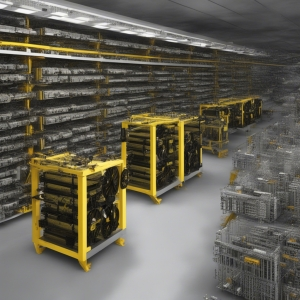Table of Contents:
Introduction
The fascinating world of cryptocurrencies, particularly Bitcoin, has seen dramatic transformations over the years. Our main focus in this article is to walk you through the intriguing Evolution of Bitcoin Mining and provide an easily comprehensible timeline highlighting all the crucial stages in this development.
Are you a beginner in the world of Bitcoin mining or a seasoned expert? This article aims to offer valuable insights to both categories of readers. Our journey will start from the roots of Bitcoin mining and will lead us to the current cutting-edge technologies employed in this field.
Get $500 free Bitcoin mining for a free testing phase:
- Real daily rewards
- 1 full month of testing
- No strings attached
If you choose to buy after testing, you can keep your mining rewards and receive up to 20% bonus on top.
By breaking down the complexities and presenting you with a clear perspective of how Bitcoin mining has evolved over the years, we aim to enhance your understanding and knowledge about this cornerstone concept in the cryptocurrency space. Let's delve into the transformative journey Bitcoin mining has embarked on since its inception.
The Early Days of Bitcoin Mining: 2009
The evolution of Bitcoin mining begins in the year 2009, with the launch of Bitcoin itself. During this initial period, mining was still a relatively simple process. This was a time when anyone with a regular home computer could participate in Bitcoin mining. Called CPU mining, this method involved using the central processing unit (CPU) of computers to mine Bitcoins.
It's interesting to note that back in those days, Bitcoin didn't have much value, and there was little to no competition among miners. Bitcoin mining was more a hobby for tech enthusiasts and was not seen as a means to make a lot of money. However, despite the minimal financial benefits, this era paved the way for the future of Bitcoin mining and set the ground rules.
Soon enough, these early days of simplicity began to transform as more people started to see the potential in Bitcoin. This sparked the first significant shift in Bitcoin mining that we'll discuss in the next section.
Pros and Cons in the Evolution of Bitcoin Mining
| Period | Pro | Contra |
|---|---|---|
| 2009 - Early Days | Easy to mine with basic hardware | Value of Bitcoin is extremely low |
| 2010 - Emergence of GPU Mining | GPU mining leads to increased efficiency | Energy consumption increases dramatically |
| 2013 - ASIC Age Begins | ASIC miners are significantly more powerful | Increased entry barrier due to high cost of ASICs |
| 2017 - Mining Farms Era | Increased scalability and lower overheads | Decentralization of Bitcoin network questioned |
| 2021 - Green Energy Mining | Sustainability issues are being addressed | If not using renewable energy, can be extremely environmentally unfriendly |
Transition to GPU Mining: 2010-2012

With the increasing popularity and value of Bitcoin, CPU mining soon became inefficient. This led to the second phase of the Evolution of Bitcoin mining, marked by the shift towards GPU (Graphic Processing Units) mining.
GPUs are better equipped than CPUs to handle the computational work required for mining. This opened up new possibilities, making the mining process faster and more efficient. The energy consumption of GPU mining was also lower than CPU mining, further adding to its advantages.
During this period, the Bitcoin network saw a significant increase in miners, leading to an upturn in competition. The greater mining power brought by the GPUs led to an increase in the overall hash rate (the speed of mining) of the Bitcoin network, indicating a substantial growth.
While the transition to GPU mining boosted the mining efficiency, it also began a trend of professionalization of Bitcoin mining. The possibility of earning substantial rewards from mining started to attract more people and businesses, gradually turning Bitcoin mining from a hobby activity into an industrial operation. This shift paved the way for the next critical stage in the timeline of Bitcoin mining evolution.
The Introduction of ASIC Miners: 2013-2015
The period from 2013 to 2015 marked a significant milestone in the evolution of Bitcoin mining. This was when the world saw the introduction of ASIC (Application-Specific Integrated Circuits) miners. These are specially designed hardware units for the exclusive purpose of Bitcoin mining.
ASIC miners upped the game, offering unmatched speed and computational power, thus, mining bitcoins more efficiently than ever before. Unlike GPU mining, ASICs are not versatile and can't be used for other tasks. However, their sheer mining prowess has kept them as the first choice amongst miners despite this limitation.
The introduction of ASICs also had a significant impact on Bitcoin's network hash rate. The power of these dedicated miners contributed to an enormous surge in the overall hash rate, translating into more competition and escalating the race for block rewards in the Bitcoin network.
More importantly, the advent of ASICs shifted the Bitcoin mining landscape from being accessible to an average computer user to a capital-intensive industrial activity. With the increasing mining difficulty brought by ASICs, the mining scene drastically changed, raising the bar for entry and setting a new standard for Bitcoin mining.
Greater Complexity and Industrial Mining: 2016-Present

The most recent phase in the evolution of Bitcoin mining has seen the process becoming increasingly complex and specialized. As the Bitcoin network continues to grow, and with the number of transactions increasing, more computational power or hash rate is required. This has led to Bitcoin mining transforming into a large-scale, industrialized operation.
The increasing complexity has ushered in the rise of mining pools, where multiple miners combine their hardware resources to increase their chances of mining a block and receiving rewards. These mining pools have come to dominate the Bitcoin network, with major pools accounting for a significant proportion of the total hash rate.
Furthermore, the locations of mining operations have also seen a shift. An increasing number of miners are setting up operations in areas with cheaper electricity to lower operational costs and maintain profitability. Countries like China, with low production costs and plenty of resources, had, for a long time, been favored. Recently, however, the dynamics are changing, with many miners moving operations due to regulatory reasons.
Another important development in recent years is the introduction of more efficient and advanced ASIC miners. Manufacturers are continually developing miners that provide greater hash rate with lower power consumption, further intensifying the competition. Despite the high upfront costs of these miners, they are becoming a necessity to stay competitive.
Clearly, the evolution of Bitcoin mining in the last five years or so has been dominated by an increase in computational power and efficiency, a shift towards mining pools, and the relocation of mining operations in pursuit of cheaper electricity. All these changes have broad implications for the Bitcoin ecosystem, influencing the distribution of mining power, the structure of rewards, and the network's security and sustainability.
Regulatory Challenges with Bitcoin Mining: An Emerging Concern
The intricacy of Bitcoin mining isn't only technological but also involves regulations and governance. With the growth and mainstream acceptance of Bitcoin, regulatory challenges have increasingly become a crucial part of the Evolution of Bitcoin mining.
Authorities around the world have responded differently to Bitcoin mining, with regulations ranging from supportive to restrictive. In some countries, Bitcoin mining occupies a gray area, with no clear rules or guidelines.
The concerns about Bitcoin mining primarily revolve around its significant energy consumption. Due to the vast computational power required, Bitcoin mining often involves a considerable amount of electricity. Some critics argue that this high energy usage contributes to environmental degradation, leading to calls for stricter regulation of Bitcoin mining activities.
Furthermore, regulatory compliance has become increasingly important as governments worldwide try to control money laundering and other illicit activities associated with cryptocurrencies. For Bitcoin miners, this could mean needing to comply with complex laws and directives, including obtaining the necessary permits, registrations, or licenses.
These regulatory challenges add another layer of complexity to the Bitcoin mining process. To navigate this evolving landscape, it's essential for miners to stay abreast of legal developments and understand how regulatory changes could impact their mining operations.
The Future of Bitcoin Mining

As we look forward, the evolution of Bitcoin mining paints an exciting yet uncertain picture. As Bitcoin's demand and value continue to surge, it's likely that mining will become even more competitive and complex. This could potentially lead to further technological advancements in mining hardware and methods.
One such potential advancement is the concept of 'green mining'. Given the growing concerns about the environmental impact of Bitcoin mining, efforts are on to make the process more energy-efficient and sustainable. Companies are developing innovative solutions such as the use of renewable energy sources for mining, which could potentially play a significant role in the future of Bitcoin mining.
Furthermore, regulatory developments could also influence the direction of Bitcoin mining. As national and international authorities grapple with the concept of cryptocurrencies, how they choose to regulate it may affect where and how Bitcoin mining operations are set up.
Overall, while much remains to be seen about the future of Bitcoin mining, it's clear that its evolution reflects the growing maturity and acceptance of cryptocurrencies. Regardless of the challenges that lie ahead, Bitcoin mining is certain to continue playing a pivotal role in the cryptocurrency world.
Conclusion
The riveting journey of Bitcoin mining from a simple computer task to an industrial-grade operation is a tribute to the growth and sustained interest in Bitcoin as the frontrunner of the cryptocurrency world. It is intriguing to see how Bitcoin mining has transformed and adapted to the ever-growing demands, amplifying efficiency, and attracting a multitude of participants along the way.
What started as an uncomplicated computational problem has now grown into a complex activity that requires specialized hardware and significant capital outlay. This evolution not only mirrors the maturing Bitcoin ecosystem but also underlines the robust, evolving, and competitive nature of contemporary Bitcoin mining.
No matter what angle you look at it from, the evolution of Bitcoin mining stands as a testament to the revolutionary appeal of Bitcoin itself. As we venture into the future, we can only wait and see how this fascinating journey unfolds and prepares ourselves to adapt with the changing landscape of Bitcoin mining.
FAQ on The Evolution of Bitcoin Mining
What was Bitcoin mining like in the beginning?
Initially, Bitcoin mining involved a simple set up of CPUs of individual computers. These were very slow and bitcoins were few.
When did the mining process change?
With increase in Bitcoin's popularity, miners started using GPUs in late 2010 for higher hash rates.
What was the next phase in Bitcoin mining?
By 2011, field programmable gate arrays (FPGA) tools were introduced. They helped reduce power consumption while improving processing speed.
How did the introduction of ASICs change Bitcoin mining?
The introduction of Application-Specific Integrated Circuit (ASIC) in 2013 further professionalized Bitcoin mining. These are custom-built chips specifically designed for mining Bitcoins quickly and efficiently.
What is the current state of Bitcoin mining?
Today, Bitcoin mining is highly competitive and dominated by specialized mining farms. Sophisticated hardware, software, and energy infrastructure are required for profitable mining.






